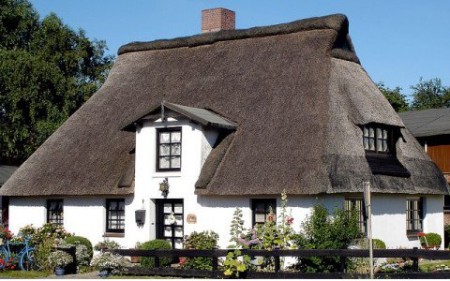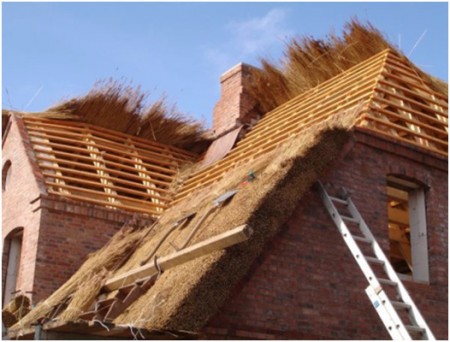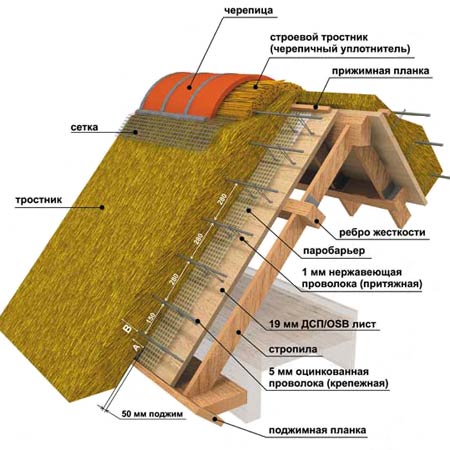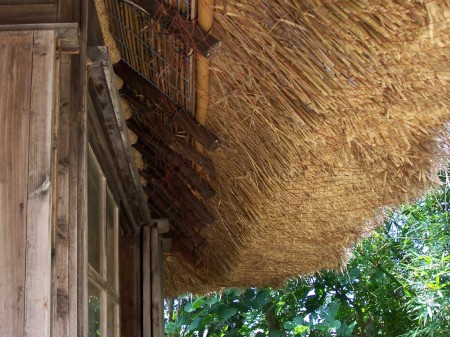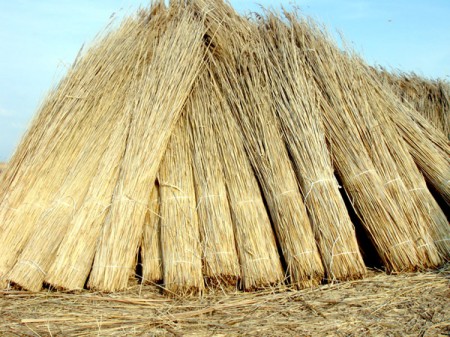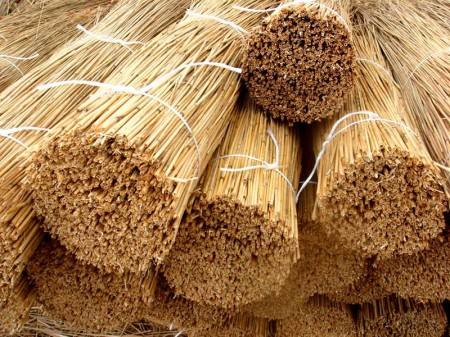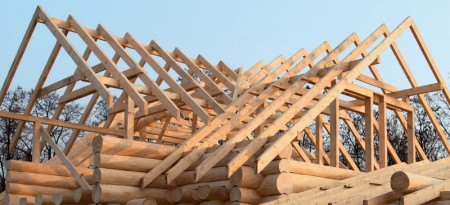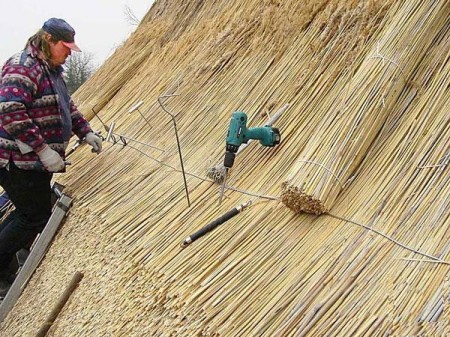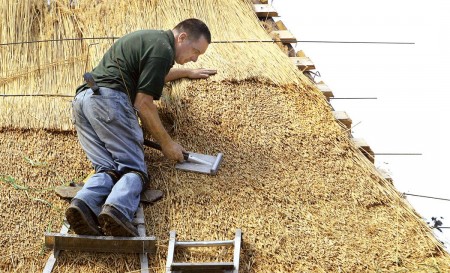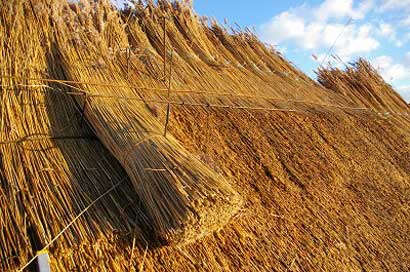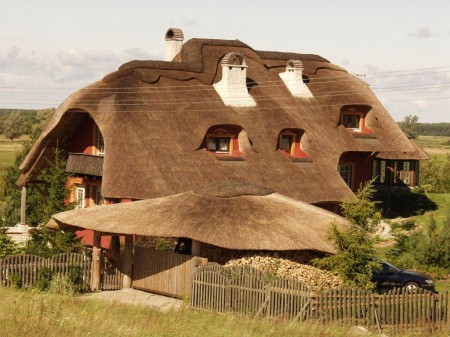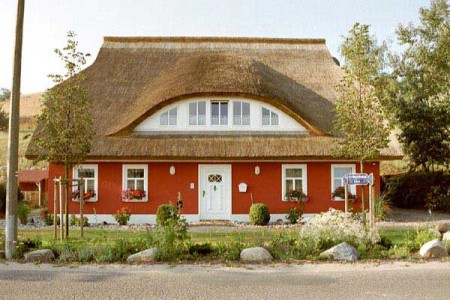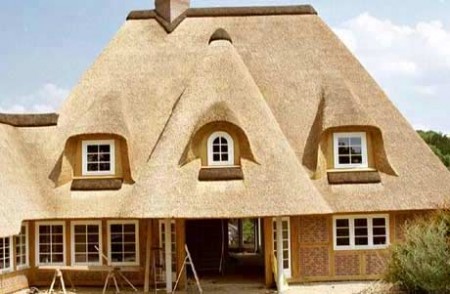"Fashion" on thatched roofs, cane and reed appeared long before mankind learned about metal or slate - in search of reliable protection of the house from the cold and rain, people preferred this roofing material. The most important arguments were their accessibility, the ability to keep warm and to delay precipitation. Over time, reed and thatched roofs were forced out of everyday use by new building materials. And only after several centuries the desire to create environmentally friendly structures, to give them an original, and sometimes even a creative look, led to a surge of interest in straw and reed roofs.
In the revival of this interest, the commercial factor played a certain role. Exclusive, unusual forms of roof made of reeds began to be built in the construction of motels and restaurants - in order to surprise and attract visitors. Attention to them drew and private developers, especially those who prefer to live in an environmentally healthy environment, who are tired of the traditional uniformity of building materials. Naturally, we understand that roofs of such natural material are subject to fire, so the owner must take care of fire safety. SNIP 21-01-97 Fire safety will help you in creating a safe living environmentally friendly homes.
Content
- 1 Properties of reeds and its advantages
- 2 How to make a roof out of reeds - features of the roof construction and arrangement of the territory adjacent to the house
- 3 How to cover the roof with reeds - the sequence of works
- 4 Do I need a fireproof impregnation?
- 5 How much does a reed roof cost?
- 6 Care instructions
Properties of reeds and its advantages
If you consider reeds as a roofing material, then first of all I want to note its extravagant appearance. It is naturally in harmony with other natural roofing materials, for example - tiles, often resort to the use of reed roof in buildings adjacent to the structures with a tiled roof, or choose a combined version in which both materials are combined very interestingly.
No less attractive are his qualities such as:
- plasticity of the stems, allowing to create complex architectural forms of the roof,
- aesthetics - noble natural shades very naturally complement the color range of the landscape design of the countryside,
- the ability to maintain a stable temperature indoors in hot weather and in severe frost,
- resistance to moisture, fungi and mold - due to the structure of the stem, moisture can penetrate inwards a maximum of 3-5 cm,
- providing natural ventilation, due to the structure of the stems and their loose fit,
- long service life.
Some mistrust of reed roofs causes the combustibility of the material, but these fears are in vain - modern methods of fire fighting can eliminate the problem. The finished roof is already treated, the composition penetrates into it only 5 cm, it has been working for several years.
Very important arguments in favor of a reed roof are its ability
- to hold rainwater,
- letting the steam out,
- it is good to keep warm.
When installing such a roof, it will not be necessary to install a hydro-, heat- and vapor barrier, which will lead to significant savings. The reed roof is approximately 10% warmer than the tin, insulated with mineral wool and trimmed on the sides with gypsum plasterboard.
In addition, reed is an excellent soundproofing device, it is not able to accumulate static electricity. Operation of the roof without additional investment is possible for half a century - it will not require repair or painting. In extreme cases, if necessary, you can safely replace any part of the roof.
How to make a roof out of reeds - features of the roof construction and arrangement of the territory adjacent to the house
An important rule of successful creation of a roof from a cane by own hands: a roof slope necessarily should exceed 35 degrees. Experts argue that the optimal option is 45 to 50, as increasing the steepness of the slope will help increase the service life of the roof.
The expected thickness of the coating should be from 30 to 35 cm. When calculating the supporting structures, it should be taken into account that the specific load on them will be from 70 to 75 kg per square meter. m.
Since the construction of the drainage system does not involve such a roof, it will be necessary to create a drainage layer along the whole perimeter of the roof, which allows to divert water to the storm sewage system. If you ignore this recommendation, then the blind area around the house will quickly become unusable, and splashes, getting on the facade, will worsen its appearance.
The construction of a reed roof should be planned only for those facilities that are located in the open area - in the shade of trees the material will not be warmed by the sun and breathe, eventually it will lead to the accumulation of moisture in it.
If the house has a wood stove or a fireplace, then it will be necessary to take measures to protect the reed roof from flying sparks.
How to cover the roof with reeds - the sequence of works
It should be noted that for the construction of the roof can be used reeds or cattails, they have some structural differences, but have the same quality characteristics. For the arrangement of the roof harvested select one-year-old stems. Cut the reeds with a special tool - tarpan. Color stems should be light, length - from 1,6 to 2 m.
Stems sort by length, from shorter can be built a roof of reeds for a gazebo, canopy or other structure with a small area. If you adhere to the rules of laying bundles or sheaves of reeds, the roof for a long time will not need to be repaired.
In a couple of years, however, you still need to fix the reed roof - any living material has a tendency to shrink.
The construction of the roof begins with the construction of the crate. For the installation of the roofing under the roof, a bar 50x50 mm or 40x60 mm is used, it is assembled with a step of 300 mm. Then the screws to which the wire or the cord restraining the sheaves will subsequently be screwed. The material is laid from the bottom, with overlapping. A wire of stainless steel is stretched through the laid-out sheaf. There is also the option, when using a rope made of natural hemp, serving as a decorative element at the same time. The place of fastening with wire is covered with the next layer of reeds.
For laying the first row of workers climb to the forest or use a ladder, with the laying of the next series - move along the crate. The overhang of the roof from the reeds should be formed at a distance of half a meter from the wall of the house. Stack the material with the same density, evenly.
When laying reeds, hooks should be used, with their help they perform temporary fastening of sheaves. Fastening of sheaves is tight, at the fixation points, reeds should stick out. Shift the next row the master determines by examining the thickness of the cover and taking into account the slope of the roof. Rules of performance and aesthetic requirements for the result cause the need to lay the material so that there is approximately 2 to 3 cm of each stem outside. To facilitate the process of leveling and padding the master's stacked material, the clover is used.
The distance between the wire and the surface of the roof should be the same - from 10 to 15 cm. After laying the sheaves, cut out the protruding pieces of stems. On a properly formed roof surface, lines, stairs, and holes should not be visible.
The roof ridge is usually made of ridge tiles, but lately it has often been used fashionable in Europe, its lacquer analog. Under the tiles have a metal mesh - to protect the upper row of reeds from birds. Tiles are laid on the latches and fastened with stainless steel wire.
Of course, those who like to learn new technologies to build such a roof will be able to do it by themselves, but you will need to learn a lot:
- how to properly prepare and how to knit a reed for a roof,
- how to build a crate and lay on it sheaves of reeds,
- how to beat and give the material aesthetic appearance,
- how to build a shingle of shingles.
In addition, you will need a very careful attitude to the work and accuracy - to get a qualitative and beautiful coverage as a result is quite difficult.
Do I need a fireproof impregnation?
Since reeds in dry form is a flammable material, the issue of fire danger for home owners is of great interest. Here it should be noted that in Europe, particularly in Germany and Holland, a special technology for reed laying, which involves the use of a special type of underlay construction.
Closed stacking is not done on the open crate, but on a structure lined with 18 mm plywood. Dense laying sheaves blocks the flow of air and prevents the possibility of burning material without a source of fire. If such a roof is treated with flame retardants, then the process of its ignition is virtually eliminated, i.e. the fire hazard is reduced to the level of similar roofing values created from other materials.
How much does a reed roof cost?
Like every creation of a true master, the roof of reeds costs a lot. It is formed from the following indicators.
- The cost of material, the procurement of which is a laborious process that can only be carried out in the winter. Often harvesting works are performed manually. If an expensive technique is used, this does not mean that the price of reeds will be lower.
- The exclusivity of the material, its environmental friendliness also plays a role.
- The work of the handler is manual work, and there are not so many specialists in the field of doing such work.
The construction of each square meter of roof from reeds in Russia can cost the consumer 60 - 120 euros, in European countries this amount is much higher - about 200 euros.
Care instructions
Although a reed roof can serve more than half a century, it will eventually break down. The upper 3-5 layers are most susceptible to changes. To prolong the life, it is recommended to restore them every 15 years.
A signal that the roof is required to rest is the formation of horizontal lines on its surface and the denudation of the dressing material.
Periodic cleaning of the surface from fallen leaves and sprouted grass will help normalize rainwater runoff. If there is a persistent germination of grass, you can resort to processing the surface of the reeds with herbicides.
Also, it is necessary to fight with the emerging moss shoots. It will require special treatment. If you can not solve the problem yourself - you will need to contact a specialist - you may need to re-segment the segment or replace it with a new one. Do not be afraid that its shade will be very different from the rest of the roof - in the course of the year the color of the new section will come as close as possible to the color of the nearby surface.



